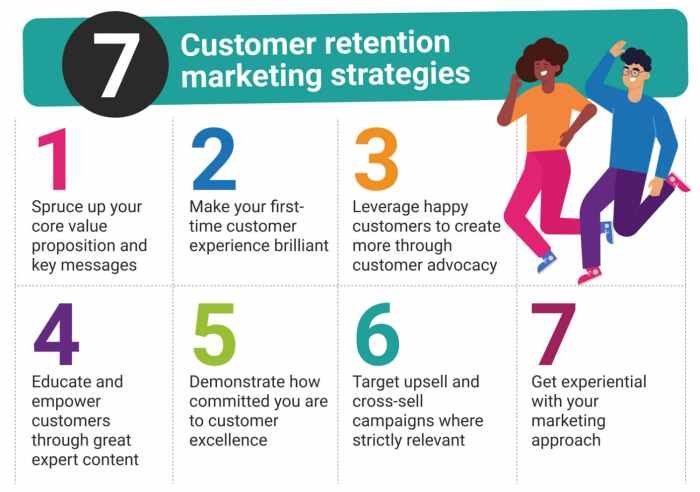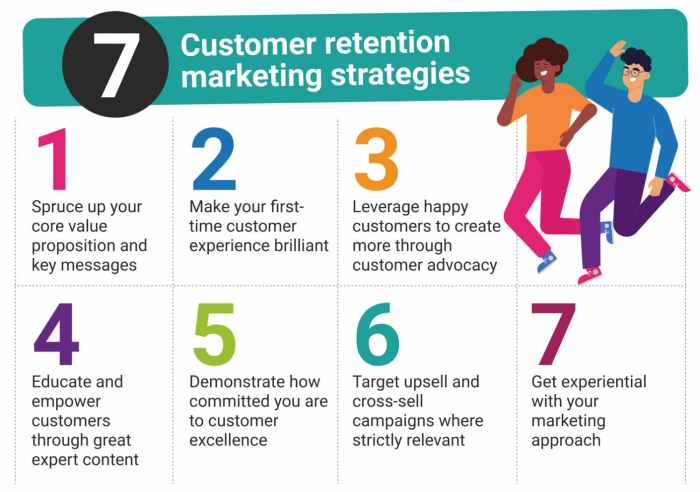Building a Customer Retention Strategy kicks off with the importance of keeping customers satisfied and coming back for more. Dive into the world of strategies that successful businesses use to ensure customer loyalty and boost profits.
Learn about the key components, implementation steps, and technology tools that can revolutionize the way you retain your valuable clientele.
Importance of Customer Retention Strategy

Customer retention strategy is crucial for businesses to maintain a loyal customer base and drive long-term success. By focusing on retaining existing customers, companies can increase customer lifetime value, reduce churn rates, and ultimately boost profitability.
Examples of Successful Companies, Building a Customer Retention Strategy
- Amazon: Amazon’s Prime membership program keeps customers engaged with exclusive perks and benefits, leading to high retention rates.
- Apple: Apple’s seamless user experience and customer service have created a strong bond with customers, resulting in repeat purchases and brand loyalty.
Statistics on Impact
“Acquiring a new customer can cost five times more than retaining an existing customer.” – Invesp
“Increasing customer retention rates by just 5% can boost profits by 25-95%.” – Harvard Business Review
Components of a Customer Retention Strategy
When it comes to building an effective customer retention strategy, there are several key components that businesses need to consider in order to keep their customers coming back for more.
Personalized Communication
Personalized communication plays a crucial role in retaining customers as it helps businesses connect with their customers on a more individual level. By sending targeted messages, tailored offers, and personalized recommendations, businesses can make their customers feel valued and appreciated.
Loyalty Programs Integration
Integrating loyalty programs into a customer retention strategy can be highly effective in keeping customers engaged and coming back for repeat purchases. By offering rewards, discounts, and exclusive perks to loyal customers, businesses can incentivize them to stay loyal and continue doing business with them.
Implementing a Customer Retention Strategy: Building A Customer Retention Strategy
Implementing a customer retention strategy is crucial for businesses looking to foster long-term relationships with their customers. It involves various steps and key elements to ensure customer satisfaction and loyalty.
Importance of Data Analysis
Data analysis plays a vital role in understanding customer behavior and preferences. By collecting and analyzing data, businesses can gain valuable insights into what drives their customers’ purchasing decisions. This information can help tailor marketing strategies, personalize customer interactions, and anticipate future needs.
- Utilize customer relationship management (CRM) software to track customer interactions and transactions.
- Analyze customer feedback, purchase history, and demographic data to identify patterns and trends.
- Segment customers based on their preferences and behaviors to create targeted marketing campaigns.
Significance of Feedback Loops
Feedback loops are essential for continuously improving the customer retention strategy. By gathering feedback from customers, businesses can identify areas for improvement, address any issues promptly, and enhance the overall customer experience.
- Implement customer surveys, feedback forms, and review platforms to collect customer feedback.
- Act on feedback by making necessary changes to products, services, or communication channels.
- Engage with customers through multiple touchpoints to show that their feedback is valued and acted upon.
Technology and Tools for Customer Retention

In today’s digital age, businesses have a plethora of technology and tools at their disposal to enhance customer retention efforts. From automated email marketing to personalized outreach, the options are endless. Let’s dive into some key technologies and tools that can help businesses boost their customer retention strategies.
Automated Email Marketing vs Personalized Outreach
- Automated Email Marketing:
- Automated email marketing involves sending targeted and timely emails to customers based on their behavior and interactions with the brand.
- It allows businesses to reach a large audience with personalized messages without the need for manual intervention.
- However, automated emails can sometimes come across as impersonal and may not always resonate with customers on a personal level.
- Personalized Outreach:
- Personalized outreach involves creating customized messages for individual customers based on their preferences, purchase history, and interactions with the brand.
- It helps businesses build stronger relationships with customers by showing that they are valued and understood.
- While personalized outreach requires more time and effort, it can lead to higher customer engagement and loyalty.
Customer Relationship Management (CRM) Software
- HubSpot CRM:
- HubSpot CRM is a popular customer relationship management software that helps businesses track customer interactions, manage leads, and automate tasks.
- It allows businesses to create personalized email campaigns, track customer behavior, and analyze data to improve customer retention strategies.
- HubSpot CRM offers a user-friendly interface and integrates seamlessly with other marketing tools for a comprehensive customer retention approach.
- Salesforce CRM:
- Salesforce CRM is a robust platform that offers a wide range of features for customer relationship management, including lead management, sales forecasting, and customer service.
- It helps businesses streamline their customer retention efforts by providing insights into customer behavior, preferences, and engagement levels.
- Salesforce CRM can be customized to suit the specific needs of different businesses, making it a versatile tool for improving customer retention.
